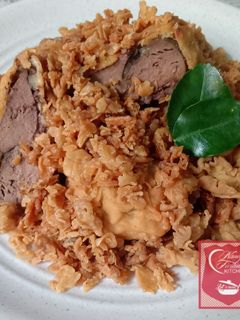Lontong Goreng Sotong is a beloved Indonesian snack that combines the comforting texture of rice cakes with the savory, tender goodness of squid. This dish is a popular street food enjoyed across Indonesia, especially in coastal regions where seafood is abundant. Its crispy exterior paired with the juicy, flavorful squid makes it a favorite among locals and tourists alike. The dish is often enjoyed as a quick snack or a light meal, showcasing the rich culinary diversity of Indonesian cuisine. Its unique blend of textures and flavors reflects the vibrant culinary heritage of the archipelago, making it a must-try for anyone exploring Indonesian food culture.
The Origin and Cultural Significance of Lontong Goreng Sotong
Lontong Goreng Sotong has its roots in Indonesia’s diverse culinary landscape, where rice-based dishes and seafood are staples. The term "lontong" refers to compressed rice cakes that are commonly used in various Indonesian dishes, while "goreng" means fried, indicating the preparation method. The addition of squid, or "sotong," highlights the dish’s coastal origins, where seafood is readily available and integrated into daily cuisine. Over time, Lontong Goreng Sotong has evolved from traditional street food to an iconic snack that embodies the Indonesian love for bold flavors and crispy textures.
Culturally, this dish is often associated with communal eating and street food culture, where vendors serve it freshly fried to passersby. It is especially popular during festive occasions and local markets, symbolizing the vibrant street food scene that is an integral part of Indonesian social life. The dish’s popularity across different regions demonstrates its adaptability and the way it resonates with various local tastes. Moreover, it reflects Indonesia’s maritime heritage, highlighting the importance of seafood in the nation’s culinary identity.
In addition, Lontong Goreng Sotong often appears during celebrations and family gatherings, serving as a shared appetizer or snack. Its role in social settings underscores the Indonesian emphasis on communal eating and hospitality. The dish’s rich flavors and satisfying crunch make it a comforting choice that connects people to their cultural roots while also appealing to contemporary palates. Overall, Lontong Goreng Sotong stands as a delicious representation of Indonesia’s culinary diversity and maritime traditions.
The dish also exemplifies the fusion of different influences, combining native rice cakes with seafood introduced through trade and coastal lifestyles. Its enduring popularity highlights how traditional recipes adapt over generations, maintaining cultural significance while embracing modern tastes. Today, Lontong Goreng Sotong continues to be a symbol of Indonesia’s vibrant food scene, celebrated for its flavor, history, and cultural importance.
Key Ingredients Used in Preparing Lontong Goreng Sotong
The main ingredients of Lontong Goreng Sotong are simple yet essential to achieving its signature taste and texture. The rice cakes, or lontong, are the foundation of the dish, typically made from compressed rice cooked in banana leaves until firm and then sliced into bite-sized pieces. Fresh squid or sotong is the star of the dish, usually cleaned thoroughly and cut into rings or strips to ensure tenderness and ease of frying. The squid is often marinated briefly in spices to enhance its flavor before frying.
In addition to these primary ingredients, a variety of seasonings and spices are used to add depth and aroma. Common seasonings include garlic, shallots, turmeric, and chili, which are either blended into a marinade or used in the batter. The batter for frying often contains rice flour or tapioca starch to achieve a crispy exterior. Some recipes incorporate coconut milk or eggs into the batter for added richness and adhesion. Fresh herbs like scallions or cilantro may be used as garnishes to enhance the dish’s freshness.
Oil is a crucial ingredient for deep-frying the lontong and squid, preferably a neutral oil with high smoke points such as vegetable or peanut oil. Additional flavorings like fried shallots, sesame seeds, or crushed peanuts can be sprinkled on top for extra texture and flavor. Some variations include vegetables like carrots or bean sprouts, which are lightly fried along with the squid for added crunch and nutrition. The combination of these ingredients results in a dish that balances savory, spicy, and crispy elements.
The quality of ingredients, especially the freshness of the squid and rice cakes, significantly influences the final taste. Fresh, high-quality squid ensures a tender, juicy result, while well-prepared lontong provides a chewy yet firm base. Seasonings should be balanced to highlight the seafood without overpowering it, creating a harmonious blend of flavors. Overall, these key ingredients come together to create a dish that is both satisfying and representative of Indonesian culinary craftsmanship.
Step-by-Step Guide to Making Lontong Goreng Sotong at Home
Creating Lontong Goreng Sotong at home involves several straightforward steps that yield a delicious and crispy snack. Begin by preparing the lontong, which can be purchased ready-made or made from scratch by cooking rice in banana leaves until firm, then cooling and slicing into bite-sized pieces. Next, clean the squid thoroughly, removing the innards and skin, and cut into rings or strips. Marinate the squid with minced garlic, shallots, turmeric, chili, salt, and a splash of lime juice for about 15-20 minutes to infuse flavor.
Prepare the batter by mixing rice flour or tapioca starch with a pinch of salt, turmeric powder, and enough water to create a smooth, thick consistency. For extra flavor, you can add a beaten egg or a dash of coconut milk to the batter. Heat the oil in a deep frying pan over medium-high heat. Dip the squid pieces into the batter, ensuring they are coated evenly, then carefully fry them in hot oil until they turn golden brown and crispy, about 2-3 minutes. Remove the fried squid and drain on paper towels to remove excess oil.
In the same oil, fry the lontong pieces until they are lightly toasted and crispy on the edges. Once both components are ready, combine the fried lontong and squid on a serving plate. For added flavor, sprinkle with fried shallots, chopped scallions, and a squeeze of lime. Serve hot with a side of spicy chili sauce or sweet soy sauce, depending on personal preference. This simple yet flavorful process allows you to enjoy authentic Lontong Goreng Sotong in the comfort of your home.
For an extra touch, some cooks like to toss the fried squid and lontong with a seasoning mix of chili, garlic, and lime juice before serving. This enhances the dish’s aroma and flavor profile. Alternatively, you can prepare a dipping sauce or sambal to accompany the snack, providing a spicy kick that complements the crispy texture. With practice, you can perfect your technique and enjoy this Indonesian delicacy anytime you crave a savory, crunchy treat.
Traditional Cooking Techniques for Perfectly Crispy Lontong Goreng Sotong
Achieving the perfect crispy texture in Lontong Goreng Sotong hinges on traditional frying techniques and careful preparation. The key is to maintain the right oil temperature—around 170-180°C (340-355°F)—to ensure the batter and lontong become crispy without absorbing excess oil. Using a deep-frying method allows the ingredients to cook evenly and develop a golden, crunchy exterior. It’s advisable to fry in small batches to prevent overcrowding, which can lower the oil temperature and result in soggy textures.
Marinating the squid beforehand enhances tenderness and flavor, ensuring it remains juicy inside while crisp on the outside. Proper batter preparation is also crucial; it should be thick enough to coat the squid evenly but not too runny. Dipping the squid into the batter and then gently lowering it into hot oil helps create a uniform, crispy coating. Turning the pieces occasionally during frying ensures even browning and crispiness on all sides.
For the lontong, shallow frying or toasting in hot oil until lightly crispy enhances its texture and allows it to absorb flavors better when combined with the squid. Frying the lontong separately from the squid helps maintain the desired crispness and prevents sogginess. Once fried, draining excess oil on paper towels is essential for a crunchy final product. Garnishing with fried shallots or herbs immediately after frying preserves their aroma and crunch.
Another traditional technique involves using a seasoned batter infused with spices like turmeric and garlic, which not only adds flavor but also contributes to a crispy surface. Some cooks recommend double-frying—frying the ingredients twice—to achieve extra crispiness, especially for larger or thicker pieces. Maintaining consistent oil temperature and frying in small portions are critical practices in traditional Indonesian street food techniques to produce a consistently crispy and delicious Lontong Goreng Sotong.
Variations and Modern Twists on Lontong Goreng Sotong Recipes
While the classic Lontong Goreng Sotong remains a favorite, modern chefs and home cooks have experimented with creative variations to suit contemporary tastes. One popular twist is adding a spicy sambal or chili sauce infused with lime and herbs, elevating the dish with a tangy, spicy kick. Some recipes incorporate cheese or mayonnaise in the batter for a creamy, indulgent texture that contrasts with the crispy exterior.
Vegetarian adaptations also exist, replacing squid with tofu or tempeh marinated in traditional spices, offering a similar crunch and savory flavor suitable for vegetarians. For a healthier take, some cooks opt for baking or air-frying the lontong and seafood, reducing oil content while maintaining crunchiness. Others have experimented with incorporating vegetables like bell peppers, carrots, or green beans into the batter or as side garnishes, adding color and nutrition.
In terms of presentation, contemporary plating often involves stacking the fried lontong and squid with fresh herbs, sliced chilies, and drizzle of sauces for visual appeal. Fusion influences have also led to the dish being served with international dips like mayonnaise-based sauces or even sweet chili sauce. Some innovative recipes include adding a touch of coconut milk or curry spices into the batter, giving a richer, more complex flavor profile.
The versatility of Lontong Goreng Sotong allows for endless experimentation, making it adaptable to various dietary preferences and modern



